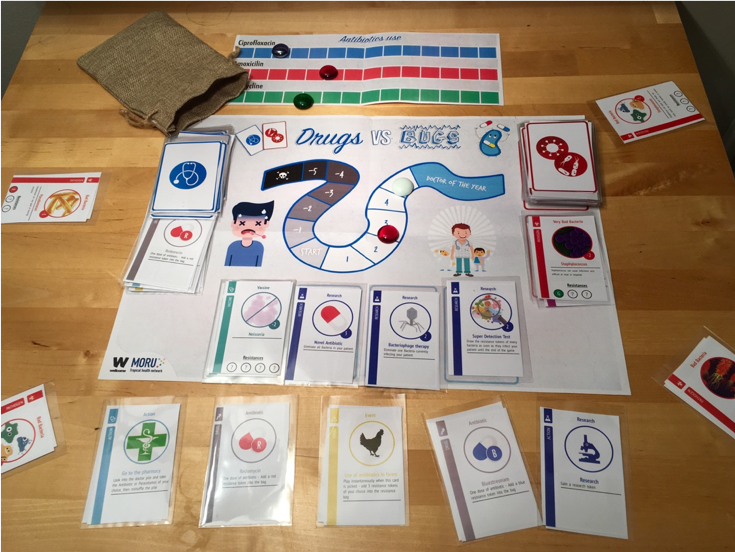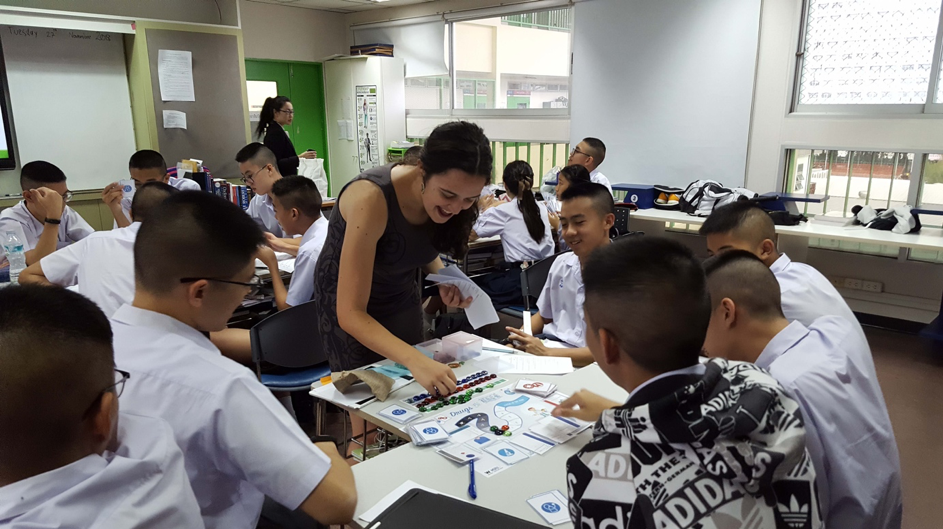‘Drugs vs Bugs’: an antimicrobial resistance board game
Posted on February 20, 2019 by Célia Souque
As a budding researcher studying antibiotic resistance, I have always tried to find fun and interesting ways to convey our research during our outreach events. For me, the answer was with board games! After developing a small card game for a lab outreach event, followed by serendipitous conversation with a collaborator in South East Asia, a project was born: I would use my Professional Internships for PhD Students placement to go and create a board game to teach about antibiotic resistance in Bangkok, Thailand.
Why go so far? South East Asia has one the highest risk globally for the emergence and spread of antimicrobial resistance. In Thailand, antibiotics are easily available over the counter, meaning that increasing public awareness of antimicrobial resistance is more important than ever.
Through my 12-week-long stay at the Mahidol-Oxford Research Unit and with help from a Wellcome Trust Public Engagement Grant, I worked on creating a board game explaining how antibiotic resistance arises and spreads – while still being fun and engaging – tailored to the Thai public. For example, the word for antibiotics is often translated in Thai by a more generic term meaning “anti-inflammatory medicine”, so I really wanted to have both antibiotics and anti-inflammatory drugs involved in the game, to help demostrate the difference between the two.

The result of this project was a board game called Drugs vs Bugs, where players take the role of a team of doctors treating patients infected by bacteria and viruses. But while they compete against each other to be the best doctor, players have to be smart with how they use antibiotics, as the bacteria become more and more resistant as the game goes on. Through the game, players can learn about the differences between bacteria and viruses, what antibiotic resistance is and how it arises, as well as how to help prevent the spread of diseases (for example through handwashing or vaccines). The game even broaches more complex topics, like bacteriophage therapy and the need for quick diagnostic tests.
I am particularly proud of the way the game explains antibiotic resistance: each time a player wants to treat a bacterial infection with an antibiotic, they first have to grab a few ‘resistance tokens’ from a bag. If a token is the same colour as the antibiotic, the bacteria is resistant. At the start, all the tokens are white (susceptible), but after each time any player uses an antibiotic, a token of the corresponding colour is put into the communal bag, so the resistance levels start rising! It shows the collective problem of antibiotic resistance really well: you may still become infected by resistant bacteria even if you personally never take antibiotics.
We translated the game in both English and Thai and ran outreach sessions in science classes in schools around Bangkok, with students between 11 and 17 years old. These sessions were a huge success and we even ran sessions with a simplified version of the game for younger kids as part of other outreach events.

I am now back in England, but the project doesn’t stop. I got to showcase Drugs vs Bugs at the e-Bug anniversary conference, which was an amazing opportunity to meet with other microbiologist board- and video- games makers, and health educators.
Finally, we are now making the game accessible as a free ‘Print’n’Play’ resource, so anyone can go and print their own version of the game (and hopefully give us some feedback too). The files for the game are currently available on this website. Don’t hesitate to play and tell us what you think!

